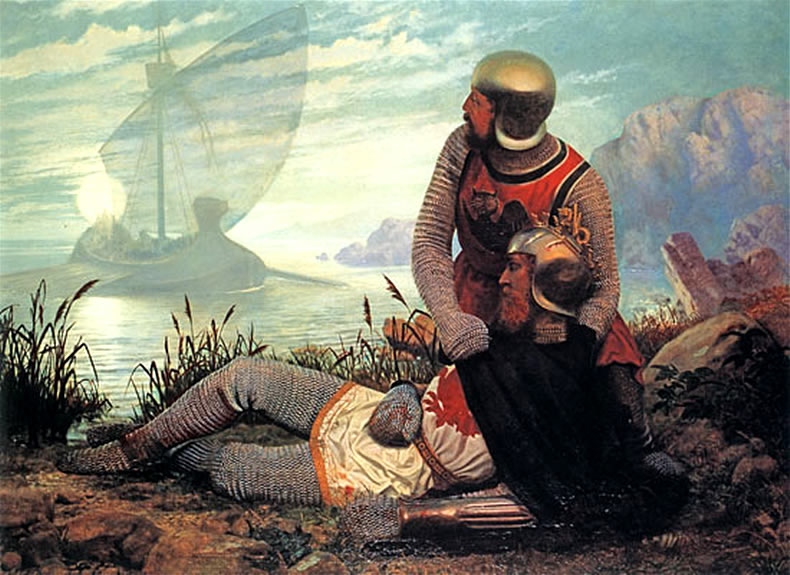“From Scythia to Camelot” is a
controversial book, arguing that the legends of King Arthur and the Round Table
are “Scythian” in origin. The term “Scythian” is a catch-all term for a number
of Indo-European peoples living on the vast steppes north of the Black and
Caspian Seas in ancient times (today Russia and the Ukraine). They spoke
languages related to Persian, and are described as “tall and blonde with fiery
eyes” in ancient sources. During Roman times, a sub-group of Scythians known as
Sarmatians acquired special prominence, having penetrated into Pannonia (today
Hungary) in Central Europe. The Sarmatians in their turn are divided into
several groups, of which the Alans were the most prominent. Unknown to many (I
certainly had no idea before reading this book), the Alans played an important
role in Late Roman and post-Roman European history, with Alan warriors settling
in Italy, France and Spain. At various points, Alan groups were allied with
Goths, Vandals and Franks, which may explain why they are unknown to the
general reader – these Iranian-speaking Scythians have simply been subsumed
under the more famous Germanic tribes. Today, a small people known as the
Ossetians in the Caucasus are said to be the last remaining descendants of the
Alans (and hence of the Sarmatians and Scythians). Being pro-Russian, the
Ossetians have become one of Putin's pawns in the complex geopolitical power
struggles in this region of the world, but that is another story, as they say!
Ossetian folk tales were studied by the great Georges Dumézil, who believed
they reflected an original stratum of Indo-European myth. The authors of this
book, Littleton and Malcor, have also studied Ossetian tales, more specifically
the so-called Nart sagas, in the belief that they represent the original
inspiration for the legends of that quintessentially Briton hero, King Arthur.
Another source of inspiration are real events in Roman history involving
Scythian groups.
It's certainly possible for Nart sagas to have diffused to the West, including Britain, due to the aforementioned migrations of peoples. (Of course, it's also possible for Arthurian romances and other Romano-Celtic myths to have diffused to Ossetia!) I don't think the authors have demonstrated any convincing parallels, however. At least to me, the similarities sound superficial. Often, the authors are forced to resort to speculation. I don't see how the pagan “sword worship” of the Scythians, including bloody human sacrifices, is in any way connected to Arthur's removal of the “sword in the stone”, for instance. That being said, the idea that some Arthurian legends, most notably those connected with the Holy Grail, are from the Middle East or even specifically Persian, has a long standing in scholarship. The question could be interesting to pursue further. Note the connection between this and esoteric traditions about secret knowledge from the Middle East (Knights Templar, Assassins, Cathars, Christian Rosenkreuz, etc). Of course, “Persian” doesn't mean Ossetian.
When it comes to actual historical events, there is one piece of smoking gun evidence. During the 2nd century, thousands of Sarmatians from the tribe of Iazyges were impressed into Roman service and sent to Hadrian's Wall in Britain. They eventually settled south of the wall. The Roman commander heading these Sarmatian forces was named Lucius Artorius Castus! Apparently, the name Arthur is of unclear provenance, but here we have a clear contender, leading Scythians to boot. The authors further argue that certain events during the sack of Rome by the Visigoths (412 AD), including a great procession with Christian holy objects, could have inspired “the procession of the Grail” mentioned in the Arthurian corpus. The Alans were allied to the Visigoths…
While this is all very interesting, the book nevertheless ultimately disappoints and never manages to conclusively prove its central theme. But then, I don't think Dumézil had much luck with his Ossetian material, either.

Det märkliga är att Graal-legenden tycks vara så attraktiv att även mörkermagiska grupper kan inspireras av den. Det gör ju förresten även matriarkaliska feminister, (Mists of Avalon).
ReplyDeleteJag har inte heller läst Arthur-legenderna. Däremot har jag sett filmen "Excalibur", som inte berörde mig särskilt. Jag kanske har felprogrammerade arketyper, vad vet jag?
ReplyDelete